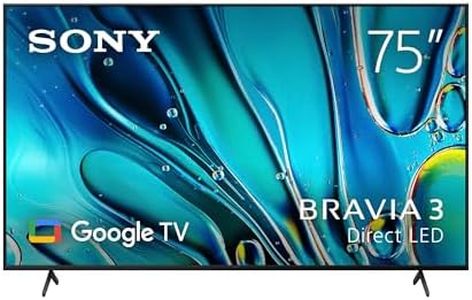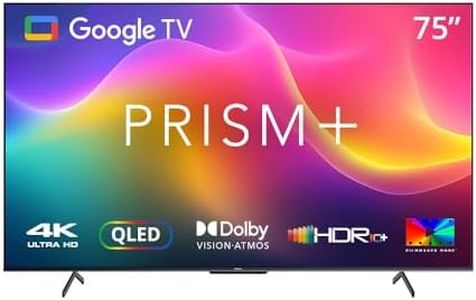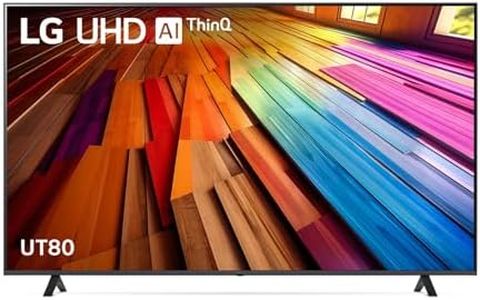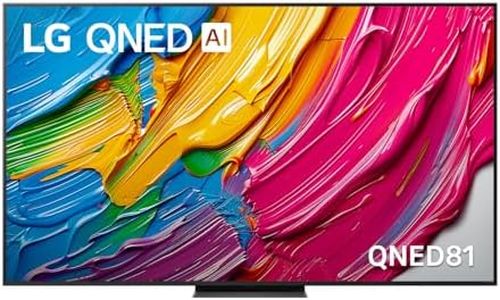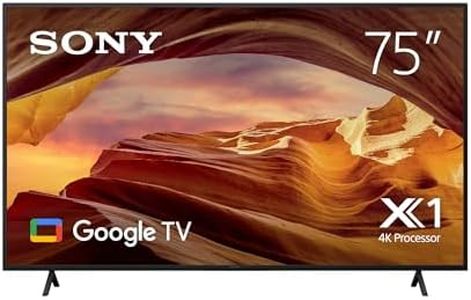We Use CookiesWe use cookies to enhance the security, performance,
functionality and for analytical and promotional activities. By continuing to browse this site you
are agreeing to our privacy policy
5 Best 75 Inch Smart Tvs
From leading brands and best sellers available on the web.Buying Guide for the Best 75 Inch Smart Tvs
Choosing a 75-inch smart TV is all about matching your home entertainment needs with the right features. Consider where you'll place the TV, the kind of content you love to watch, and how you'll use smart features like streaming or voice commands. Since a 75-inch TV is quite large, make sure your viewing space can accommodate the screen size comfortably, allowing you to sit at an appropriate distance for an optimal viewing experience. Focusing on key technical specifications will help you cut through the marketing noise and find a TV that will bring movies, shows, and games to life in your living room.Display ResolutionDisplay resolution refers to the number of pixels that make up the picture on your TV screen, with common options like Full HD (1080p), 4K (Ultra HD), and 8K. Higher resolutions offer sharper, more detailed images, especially important on a large 75-inch screen where lower resolutions can look blurry if you sit close. For this size, 4K is generally the sweet spot, giving you crisp visuals and broad content availability. 8K is a newer, pricier tech that's only useful if you want the absolute latest or sit very close, but content is still scarce. 1080p is now considered outdated for such a large screen. Choose resolution based on your content sources and how much detail you want.
Panel TypePanel type affects how your TV displays colors, brightness, and viewing angles. The main types are LED, QLED, and OLED. LED panels are widespread and affordable, providing good brightness but sometimes average color depth. QLED adds a layer for richer, more vibrant colors and works great in bright rooms. OLED technology produces the best contrast and deeper blacks, with superior viewing angles, perfect for watching movies or sports from all over the room. If you mainly watch TV with the lights off and appreciate cinematic quality, OLED stands out, while QLED and LED suit general or brightly-lit use.
Refresh RateRefresh rate measures how many times per second the TV updates the picture, usually shown as 60Hz, 120Hz, or higher. A higher refresh rate means smoother motion, which is especially helpful for action movies or fast-paced sports. For most users, 60Hz is adequate for standard viewing, but gamers or sports enthusiasts may prefer 120Hz for the smoothest look. Pick the refresh rate that matches your viewing habits: higher rates for lots of sports and gaming, standard for TV shows and movies.
Smart TV FeaturesSmart TV features encompass the built-in operating system, apps, voice assistants, and connectivity like Wi-Fi and Bluetooth. Look for a TV with a user-friendly interface that supports your favorite streaming apps and services. Some offer advanced voice control or integrate with your smart home devices. Consider what apps and features you use most—whether it's streaming, web browsing, or controlling lights from your couch—and make sure your chosen TV supports these smoothly and reliably.
HDR SupportHDR, or High Dynamic Range, is a technology that helps TVs display a wider range of colors and brighter highlights, making scenes look more realistic and immersive. There are different HDR formats like HDR10, Dolby Vision, and HLG. If you enjoy high-quality streaming or gaming, a TV with HDR support can make the picture pop, especially in dark or colorful scenes. Check which HDR formats your favorite content uses and make sure your TV supports at least HDR10 for broad compatibility.
ConnectivityConnectivity covers the types and number of ports, including HDMI, USB, audio outputs, and wireless options. More HDMI ports let you connect game consoles, soundbars, and streaming devices at the same time, while USB ports are handy for photos or extra storage. Think about all the devices you plan to hook up to your TV and ensure it has enough compatible ports—add a few extras for future-proofing.
Audio QualityAudio quality refers to how well the TV's built-in speakers reproduce sound. While large TVs can sometimes have underwhelming speakers due to slim designs, some offer enhanced sound systems with better clarity and bass. If you watch regular TV shows, built-in speakers might suffice, but movie buffs or music lovers may want to check for special audio features or plan to add a soundbar or home theater setup. Consider your space and your expectations for sound when making this choice.
Viewing DistanceViewing distance is about how far you should sit from your TV for optimal comfort and picture clarity. A 75-inch TV is best viewed from about 8 to 10 feet away; sitting too close can make the image look pixelated, while too far can diminish the immersive experience. Measure your space in advance to make sure you have room for such a large screen and position it at a height that doesn't strain your neck.
